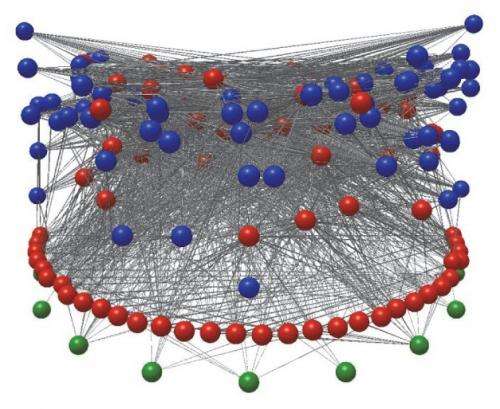A network of 4,671 feeding interactions among 68 parasites (in blue) and 117 free-living taxa (green = basal taxa, red = consumers) in the food web of Estero de Punta Banda, Baja California, Mexico. The vertical axis corresponds to trophic level. Credit: Images produced by J.A. Dunne using Network3D software
Parasites comprise a large proportion of the diversity of species in every ecosystem. Despite this, they are rarely included in analyses or models of food webs. If parasites play different roles from other predators and prey, however, their inclusion could fundamentally alter our understanding of how food webs are organized. In a paper published 11 June in the open access journal PLOS Biology, Santa Fe Institute Professor Jennifer Dunne and her team test this assertion and show that including parasites does alter the structure of food webs, but that most changes occur because of an increase in diversity and complexity, rather than from unique characteristics of parasites.
"Current food web models and theory were developed with data for free-living species," said Dunne. "We wanted to understand whether including parasites alters network structure in unique ways, or if observed changes are consistent with the addition of any types of species and links to a food web."
The group of researchers, which included parasitologists and food web ecologists, analyzed highly resolved datasets for seven coastal estuary and marine food webs. They compared three versions of each food web dataset: webs without parasites; webs that included parasites and all of their links to other species; and an intermediate case that included parasites but excluded the "concomitant" links between a predator and the parasites of its prey.
The team found that including parasites altered many aspects of network structure, such as the distribution of feeding links per species, the average shortest feeding chain between pairs of species, and the proportion of species that are omnivores or cannibals. But a closer look suggested that most of these changes were generic effects of increasing the overall diversity and complexity of the network, rather than unique effects attributable to the parasites' roles in food webs.
"Our analyses show that in many ways parasites are similar to other species in terms of their effects on food web organization," said Dunne. However, the team did find two cases where parasites seem to play special roles that alter aspects of food web structure. One case is when a parasite is eaten along with its host. "The physical intimacy between a parasite and its host is not found as frequently between free-living predators and prey," Dunne said. "The fact that predators incidentally feed on the parasites of their prey can alter certain patterns of interactions among species."
The other case appears to result from the complex life cycles of many of the parasites in these food webs. Parasites can shift hosts in a dramatic fashion, for example by starting out with a cricket as a host, but later requiring a fish host. This results in a more structurally complex feeding niche than is seen for most free-living predators.
"Our research extends the generality of food web theory and provides a more rigorous framework for assessing the impact of any species on trophic organization," said Dunne. "However, it also reveals limitations of current food web models when they are applied to the more diverse and highly resolved data that researchers are increasingly compiling."
More information: Dunne JA, Lafferty KD, Dobson AP, Hechinger RF, Kuris AM, et al. (2013) Parasites Affect Food Web Structure Primarily through Increased Diversity and Complexity. PLoS Biol 11(6): e1001579. doi:10.1371/journal.pbio.1001579
Journal information: PLoS Biology
Provided by Public Library of Science





















